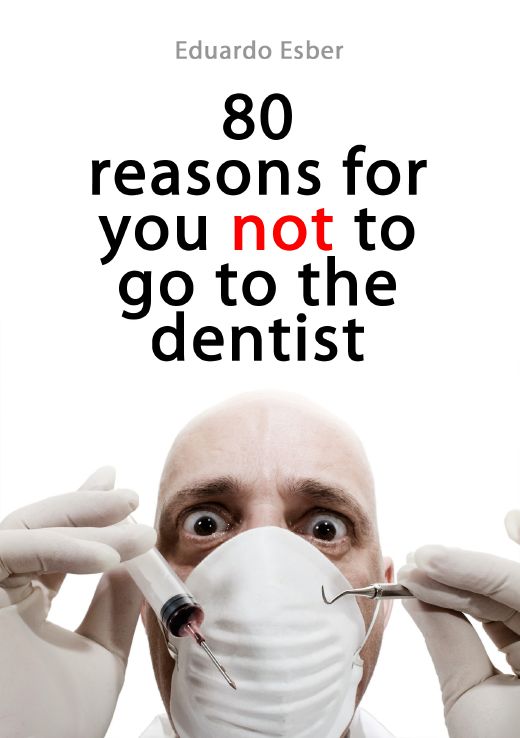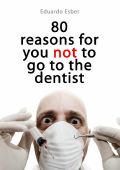
CLICK and see The Trilogy of the Dentist
3• It can seem to be just
a little,
but it’s still blood
There’s a fact that not many people know or acknowledge, or even realize. Here it is: most of the procedures there are done inside the mouth, by a dentist, cause some sort of gingival bleeding, for the most part, these are minimal bleedings, not noticed by the patient. It can be easily checked out: the gum embraces all our teeth and it’s very unusual for an intervention, especially the ones between two teeth, to not result in some kind of gingival bleeding, during the intervention or at the finishing touches. In most cases, it’s a minimal bleeding, if added all together, the volume of lost blood wouldn’t come to a drop, but it’s still blood. That’s why patients don’t realize it. Some other times, the dentist splashes water inside the patient’s mouth, so that little drop of blood is diluted and, with the help of the saliva ejector, sucked all out of your mouth. In conclusion: the patient would never figure out that there was a gum bleeding. Also, the dentist won’t tell the patient everything that is going on. One of the dentist’s role is to soothe the patients, not to frighten them.
Now, picture this: a dentist uses a variety of tools in your mouth, many which are knifelike. Of course, the blood will get in touch with these tools. Said tools are not disposable. They’ll be used for other patients as well. I can even list one: The Gingival Margin Trimmer. The name speaks for itself. Have you stop to ponder you could be one of many patients? Of course, the dentist will tell you that everything is disinfected and sterilized, but can you be sure? It could be the case, but there will always be a little doubt inside your head, because a lot of the steps in a practice don’t rely on the dentist himself and these are hardly completely controllable. Would you take that chance?
To paint you a picture, these are some blood transmitted diseases, the same blood from the dentist’s patients’ gums: Hepatitis A, Hepatitis B, Hepatitis C, Syphilis, Chagas disease… including the AIDS. There’s a confirmed case of an American patient who got AIDS through a dental procedure. This case was brought to attention because it was the AIDS, but we need to be aware that there’s not only the AIDS! These countless other diseases are as contagious as the AIDS and you can be the next victim. Think carefully the next time you chose to go to the dentist. It can save your life!

24• But I’m not like that…
Speaking of anesthesia, if you’ve ever been under it, you must remember how bad is that numbness feeling in the mouth, the swelling, and at the same time, seems like there are thousands of ants under your skin. It’s awful.
Therefore, shortly after the shot, that numbness feeling can be felt inside and outside of the mouth, it spreads and becomes more intense gradually. You can add to that, the fact that your mouth and face, on the side where the shot was given, are, at least, twice as big, swollen. It really is awful.
If the anesthesia lasted only the time of the dental procedure it would be great, although this should not be enough for you to reconsider going back to the dentist. Another issue is the fact the anesthesia persists for hours after the appointment is done. In other words, the patient put under anesthesia will continue to stay under its effects for hours still, working off the procedure, along with all that face numbness, like if there were a thousand pins poking you at the same time, plus a swollen mouth. It really is awful, indeed.
There are also other undesirable effects. The anesthesia makes our mouth a little crooked. Even speaking naturally, due to the numbness feeling, is troublesome. As it affects our nerve endings, we cannot feel what’s inside our mouth until it’s gone. Then, even if there’s some extra saliva inside our mouth, we won’t be able to notice. It’s normal for people under anesthesia to drool a little, they won’t notice it, because there was some extra saliva there and there’s no feeling of it, for it to be swallowed.
Now, imagine you have a crush for a while, and finally your crush is flirting back with you. This is that beginning phase of the flirting where you know it’s going to happen, but there’s also the expectation of when and where will it happen. Imagine you went to the dentist, you were put under some anesthesia and then left. As soon as you cross the street, right outside of the doctor’s practice, you see, of course, your crush, walking towards you. Your crush is happy to see you and gives you the biggest smile, that makes you daydream for a while. You, obviously, will also smile back, a bad temper does not agree with the heart. What will your crush think of when you smile back with your crooked drooling mouth? They’ll probably think you came out of a bad thriller movie. And this, for sure, will cause a big impression, hard to forget afterwards. You can count on losing about 95% of your chances of seducing your crush.
Although… Let’s assume your crush saw you looking like that, it was shocking, but at the same time, they felt really sorry for you and decided to buy you a drink. As embarrassed as you were feeling, you couldn’t say no. So, off you go to some coffee bar nearby. You know what would happen? Due to the anesthesia’s numbness on the inside of your mouth, it’s very likely you won’t be able to drink even a juice properly, you would make that horrible sound of a straw on an empty glass. You could even pour some of the juice out of your mouth by the sides. The food could be stuck outside of your mouth and you wouldn’t feel a thing. You would chew funny, noisy and with a completely crooked mouth. And you would still be drooling… When your crush asked you anything you would answer it rambling and weirdly.
Thereafter, your 5% chance left vanished completely. And it would not be surprising to notice, after the anesthesia effects run off, the inside of your cheeks to be painful and hurt. Due to the anesthesia, you ended up chewing your own cheeks without realizing it. Your crush would be terrified and thinking it was a great deal not going forward you sooner.

33• Natural is better
You must have heard of dental prosthesis, right? Dental prosthesis is, usually, everything that is manufactured outside of the patient’s mouth and adjusted afterwards. As an example, there are dentures, removable partial dentures, fixed bridges, metallic incrustations, the ones called pivot crowns, the “jacket crowns” etc.
For the process of making any dental prosthesis, firstly the dentist will take an impression of your teeth or the affected area and send this mold to a dental lab. There works the so-called prosthetic technician, they’re the ones responsible for, from your oral mold and the information passed on by the dentist, manufacture the prosthesis, from a denture to a simple jacket crown. By the way, it’s always best to use the term “total dental prosthesis” than to use “denture”.
It has always been a concern for Odontology, when making dental prosthesis, on any kind, for it to be the most natural-looking possible, in a way it’s very similar to what natural teeth look like, or even for it to be impossible to distinguish. The dental labs with high quality standards are always investing on proper technology, through devices and new materials that are able to copy with excellence the natural teeth look.
Now check this out: do you know what the state-of-the-art dental labs are doing in order to perfect the natural-looking teeth results? They’re replicating decays on the artificial teeth to provide a more natural and better-looking output. Using coloring it’s possible to achieve the multiple colors found on a decayed tooth and this can be done to the artificial teeth. The final result is amazing.
Now check this out, one more time: while these labs are investing so much money to achieve the decayed-look result on artificial teeth, you, already owning them naturally in your teeth, would want to get rid of them? As much effort as these labs are putting in, they will never be able to repeat a more perfect and prettier decay as the one already inside your mouth. In this sense, you are a privileged person. Smile with joy and without fear of showing your teeth.

38• Another invisible danger
Nowadays, every basic dental practice will own an X-Ray machine. With the X-Ray discovery, on 1895, by a researcher from Munich, Germany, named Wilhelm Conrad Röentgen, a new perspective for diagnostics were presented, for the treatment of a variety of afflictions of the human body. The Odontology field was widely enhanced by the X-Ray discovery. The Dental Radiology arouse and from that point forward another realm of possibilities, wider than the first mentioned, was presented to the most diverse dental specialties. Currently, the X-Ray is of great value for most of the dental specialties or, why not, to all of them? Even on those treatments where an X-Ray is not necessary, of course, if it is taken, anyway, there are only perks to it, providing a better visualization of specific parts and deeper structures that would not be visible otherwise and improving excessively the quality of the final result.
That’s great, right? This is such a good story, it seems it’s from a fairy-tale book. But this is only one side of the history, and usually the only one presented. Now let’s see the other side of it. It’s like a trial, where you get to be the judge. The Defense has already presented its case. Now it’s time for the Prosecution.
For the start, let’s remember that Röentgen had his fingers cut off and died from cancer, surely due to the radiation he was exposed to. After him, other researchers also had parts of their bodies cut off due to the X-Rays.
Even only one simple X-Ray procedure can cause problems that you wouldn’t even imagine. That’s why a lead apron, or one made of lead rubber, is required for the patient, on any X-Ray procedure, of any kind, even if the X-Ray issuance is for less than half a second, for example.
Assume you have a ten, or eleven years old daughter, for instance. At this age, her eggs are still fragile, in a way, and extremely sensitive to radiation. Assume now that this daughter of yours went to the dentist and had some X-Ray images taken and, for her misfortune, without the lead apron, which, by the way, is an exception on these practices. There’s a huge chance, directly related with the power of the X-Ray machine, that this radiation will cause a malfunction on one, two, or maybe more of your daughter’s eggs. Afterward, in any given age, your daughter decides to have a baby, and, by chance, the fertilized egg is one of these with the malfunction due to the radiation your daughter went through while at the dentist, do you know what would happen? You could have a defective grandchild, or one with a mental disorder or any other issue, that’s almost impossible to predict. Even on men, in which the gonad region is very sensitive to radiation too, if one has its testicles exposed to radiation and, by chance, one of the affected sperm take part on the conception, there’s no doubt there will be future problems on this child. Radiation is a serious matter and highly underestimated by many people who work with it. Would you take that chance?
If you go to a dentist, probably, surely, guaranteed and possibly, he’ll order an X-Ray. And what? Do you know if he’ll have a lead apron on his practice? Do you know if the kilovolt-ampere rates on the X-Ray machine are adjusted? What if the machine is conducting more radiation than it should? Do you know if the machine’s timer, which regulates how long the X-Ray will keep going, is working properly? “- Oh my God, the apron is not protecting me properly and the machine will go off, what do I do?” This are some questions a wise person, such as yourself, should do, while going through any dental procedure. Is it worth it going through all that risk?
Well, my fair judge, you’ve heard the Defense and just a little of the Prosecution, which has not spoken any further because the author of this book has other reasons to write about and this book is not only on X-Rays. Your sentence is awaited. Not one to convict, or not, the X-Ray, because it’s already doomed since Röentgen lost his fingers, but one deciding whether you should or shouldn’t go to the dentist, between all this risk and danger.

47• The torture root
Have you ever imagined yourself going through a root canal treatment? If you’ve ever been through one, you know what I’m talking about. If you’ve never had it, it’s really difficult to picture that amount of suffering, never going through it. As you’ve already seen, during any dental procedure, when you least expect, you can be awarded with the news you’re in need of a root canal treatment.
Assuming you are the victim that will go through the misfortune of having a root “treated”. You’ll be worrying, for hours prior to the appointment, about the pain and discomfort you’ll feel. Ask someone who has already gone through this is worse, this will only make you feel tighter and more anxious. If you’re dealing with number and calculations, stop! Your head will be running on high gear and it’s quite possible you’ll end up making some mistake. At the waiting room at the dentist’s practice it will be clear your concern. You’ll be going through the magazines very fast and with shaking hands, without really reading anything, just to see if you can forget about it. The assistant will try to start a conversation, but you’ll be not in the mood for that either. When the patient before you leaves the practice room, your heart starts to race. You know you’ll be next. In these moments, it’s natural to wish for something to come along, for the dentist to receive a phone call and, suddenly, he needs to leave, for the practice’s compressor to break down etc. But none of that happens and the dentist calls you in. Your heart races even faster. When you stand up, you realize the spot you’re sitting on is moist. You’ve been breaking out in a cold sweat. At the dentist’s chair, you’ll pretend you’re ok, but it won’t be enough. He knows you’re anxious because he’s been educated to notice this stuff. He says somethings to make you feel less anxious and starts to get the shot for the anesthesia ready. As your tooth’s nerve will be weeded out, the anesthesia needs to be very strong. The size of the needle is disturbing, so you shut your eyes and he gives you the shot. As you feel very tense, the shot hurts even more. As soon as he removes the syringe off your mouth, you feel better. Your face is so numb and heavy, seems like there’s a brick tied to it. Then, the dentist will cover your entire mouth with that rubber dam. You feel smothered with all that junk covering your mouth. That suction device he’s placed under your tongue is starting to hurt you. Then, after a lot of drilling action, the dentist was able to expose your tooth’s nerve. Firstly, he’ll grab a tool named curette or another one called spoon excavator, or both, and begin digging on your tooth’s nerve, removing bit by bit. You feel terrible watching all those red blood blobs he removes from your tooth. Suddenly the dentist takes the syringe again. Your eyes widen, you think it’s for another anesthesia.
“_No!” – says the dentist. That syringe has some fluid to wash off your tooth. The dentist starts to wash it off and some of that liquid spills off through the rubber dam and inside of your mouth. You startle when you realize that bleachy taste on the liquid, you flinch, but unavoidably you end up swallowing some of it. Your turn and see the dentist looking for something on a little box next to him. All of a sudden, he turns back with an endodontic file on hand, that little needle used to poke the root of your tooth. Your face loses all the blood at once and you begin to wonder in what situation you’ve put yourself in. When he starts to poke that needle in your tooth’s root, you jump up on the chair, from the pain. The dentist removes the needle, and asks you, as if nothing has happened:
“_Did it hurt?” You feel like telling him: “_Of course not! It just tickled a little.” Or you could say you forgot your spasm medication at home. However, with that dam over your mouth, you can’t really say anything. And just like that, you see the syringe on his hand again. You think he’ll wash off your tooth again. Honest mistake. Now it really is for the anesthesia, and it will be inside of your tooth’s root, right above the already exposed nerve. Bam! You feel one of the greatest pains you’ve even felt before. You even shrink on the chair. You’re glad it was over fast, you think. But yet again, the dentist starts with that terrible little needles. He keeps sticking it in and out of your tooth, taking turns. It starts to hurt again, you let him know, but the dentist asks you to hang on, that it’ll be over soon. You notice that every new needle he takes from that box is getting thicker and thicker. And the pain is rising up… At some point, after all of that suffering, the dentist stands up and asks you to hold an X-Ray film in position in your mouth. After the X-Ray is done, he says he’ll close up your tooth. You feel relieved. At last that torture session is over. He removes that dam off your mouth, and you sigh of relief. You feel like a champion for holding on to all that. And that peacefulness air, that was around you, suddenly turns back and starts to swirl, when the dentist tells you to schedule another appointment to continue with your root canal treatment. You feel deflated immediately when you’re told it will take two more sessions like the one you just went through for your root canal treatment to be done. You leave the practice devastated and wishing for the world to end soon.
What a nightmare, huh? I think you wouldn’t wish this to you worst enemy. Just know that, from the moment you step foot on a dentist’s practice, this is only one of many possible nightmares you’ll be endangered of living.

77• A true history
This one comes from my professional experience. This will show you, definitely, that odontology has also a backstage and the people who go to a dentist can never really know what’s going on there. Will show you a shocking reality of the backstage of a simple dentists’ practice for the low-income community. This will show you that there are people only worried with themselves and with the people they profit over, without caring for others.
As soon as I got my graduate degree, I was looking for a job, as all recent graduates are, I got one in a place I’d be attending the city’s low-income community. We’re a group of many dentists, and each one of us were appointed to a specific location. Some were appointed to public schools’ practices and others to health centers on the neighborhoods. I would work on a practice that, like the others, was funded by public funds, originated partly from the many taxes people were charged.
I would see many different people on this practice, from children to the elderly. They were humble people that, due to their poor background, did not need much. Of course, the more elaborate treatments were not performed there, just the ones the supplies and tools available made it possible. More important than the treatments done on the patients was my concern for hygiene and asepsis, because of the variety of people treated there, it required accuracy and attention to detail, aiming to prevent infections and diseases. It was best to not treat a patient than to expose him to any contamination hazard, causing him any disease from the patient treated before him.
Much to my surprise, one day when I got to the practice, the cleaning lady let me know that a letter has arrived for me. Even worse when I read its content. In it, the guy responsible for the city’s dental services said I should not use different disposable gloves between patients and, if I did not agree with it, I should just quit. You must be shocked as well, aren’t you? But I’m telling you the truth. Surely, this guy, to find out I was using different gloves between patients, must have been going through the trash cans on the practice after opening hours. Even though there were funds to treat the low-income community with dignity, he was trying to cut back, maybe looking for some type of upgrade on his career, subjugating these people to total disregard and lack of hygiene. Why? Just because they had limited funds? I wonder if the city did not have the assets to fund each treated person’s pair of disposable gloves.
None of the patients that were treated there found out about this. I did not know how it ended up, or how it is today. The contempt of those patients’ treatment is daunting. Without a doubt, if they knew about it, they’d pay for the gloves used on them themselves. As a matter of fact, the cost of a pair of gloves is similar to the cost of a sweet, which is given out in buckets by the city during any type of celebration where children take part in. It’s possible the other dentists, if they were also discarding the gloves after each treatment, got a similar threat as I did. A lot of them needed that job and I’m not sure about the outcome of the whole history. It saddens me to know that this type of thing is not unusual and that exactly the people in need are the ones to suffer the most. Among all these drawbacks happening still today, who knows if the patients treated on these circumstances, thinking they are getting a good thing with that treatment they’re receiving, would be better off If they did not have gone to the dentist at all?

 |
 |
| PAPERBACK |
KINDLE |